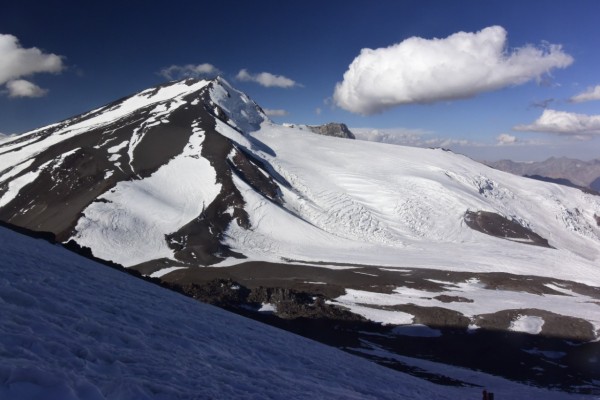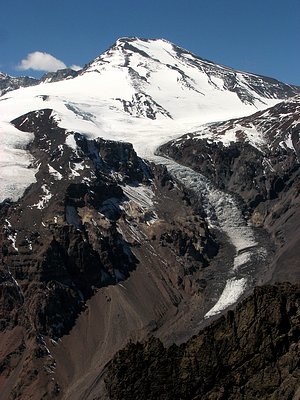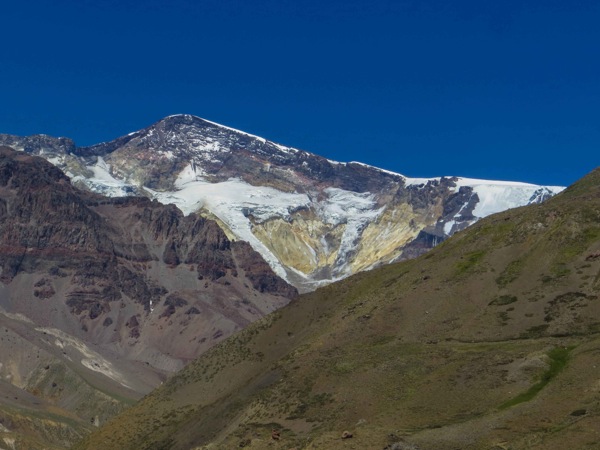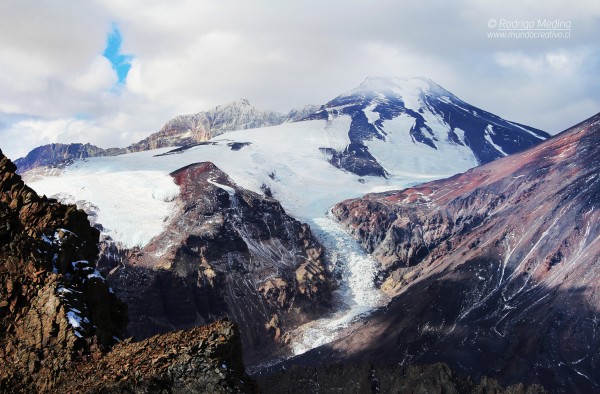Summary
General Information
Cerro Marmolejo
Acceso libre
Location: Chile, Región Metropolitana
Argentina, Provincia de Mendoza
Area: Volcán San José
Nearest city: San José de Maipo
Altitude:
6108 m.
6100 m. Lliboutry
Year First ascent: 1928
First ascent:
Albrecht Maass (DE-CL), Hermann Sattler (DE-CL) y Sebastian Krückel (DE-CL)
Geographic position:
Lat: -33° 44' 4.7" (WGS 84)
Lon: -69° 52' 41.1"
Alta Montaña
Routes
Summit Book
Last Update
Mountain
Cerro Marmolejo (6108 m.)
Author: Paulo Cox
Routes: Estero Marmolejo Estero Salinillas Ladera Oeste, Estero Marmolejo Ruta del Portezuelo Marmolejo Stream
Updated at 23/12/2020
Introduction
Cerro Marmolejo, located on the Chile/Argentina border, is the southernmost six-thousand meter peak of the Cordillera de los Andes (and of the world).
One of the mountain´s main characteristics is a great glacier -the Marmolejo Glacier- which has a maximum extent of 20 kms. This fact, and the long approach required to reach base camp, have made it deserve the nickname "muy muy lejos" (which sounds a lot like "Marmolejo" and means "very very far") among mountaneers.
From the chilean side of the Andes, Marmolejo can be seen somewhat cornered towards the east, as Vn. San José's and Nevado Piuquenes's (also called Nevado San Juan) eternal neighbor.
Reaching Marmolejo's summit is a very arduous and demanding enterprise regarding time and physical conditioning, but rewards with a privileged place from where to contemplate the Earth's curvature and the vastness of Argentina's valleys.
Hypothesis about the name of the mountain*
The word marmolejo, in the Spanish tongue, means "small column." Although the mountain does not have the shape of a column, if it did, it would certainly not be a "small" column. This oddity motivated a deeper study concerning the name of the mountain.
According to studies of the author of this presentation, Marmolejo was baptized in honor of who is considered Chile´s first historian, don Alonso de Góngora Marmolejo. Don Alonso,native Andalusian of Carmona, arrived to Chile with the conquering expedition led by Pedro de Valdivia. He wrote Historia de Chile, a chronicle written between the years 1572 and 1575, year in which he died, shortly after being named by Rodrigo de Quiroga Captain and Judge of the commission for the punishment of indigenous practitioners of witchcraft. Alonso Góngora de Marmolejo´s Historia de Chile comprehends the period which goes from 1536, year in which Almagro stepped for the first time into Chilean territory, to 1575. It is a shallow and unclear chronicle, which lacks further analysis, although, in opposition to other narrations of the time, it doesn´t include pedantic references nor descriptions far from what really happened; the style is sober, direct, concise and dry at times.
Of the Kingdom of Chile he wrote**:
"tierra de la manera de una vaina despada, angosta y larga" (narrow and long strip of land, as the sheath of a sword, ); and: "Danse las frutas y los árboles della mejor que en España [...] (Fruits and trees grow better than in Spain); críanse buenos caballos, mucho ganado de toda suerte [...] (fine horses are bred, much cattle of all kinds); la mar y la costa della tiene grandes pesquerías, buenos puertos para navegantes" (the sea and coast are rich in fish, good harbors for sailors).
About the people (together with Ercilla´s "La Araucana", Marmolejo begins what would develope into the myth of Chile being a warring nation): "Son los más belicosos indios y guerreros que se han visto en todas las Indias, y que no pueden acabar consigo a tener quietud, sino morir o libertarse" (They are the most bellicose indians and warriors of all the Indias, unable to remain still, just capable of fighting or gaining freedom).
The peak would have been likewise named by the Chilean Borders Commision which, between 1875 and 1909, and together with the Argentine Borders Commision, mapped nearly 2600 kilometers of Andean frontier, when both nations agreed to establish their borders peacefully. In charge of the Chilean Commision was engineer Luis Riso Patrón.
Notes:
*I am thankful to don Mario Araneda for the first lights he shed on me and which motivated this research; don Mario was part of the expedition of the famous "cordada de oro" in 1943, which climbed the mountain for the first time from Chile.
**Notes from "Historia de Chile" obtained from the Annals of the Universidad de Chile.

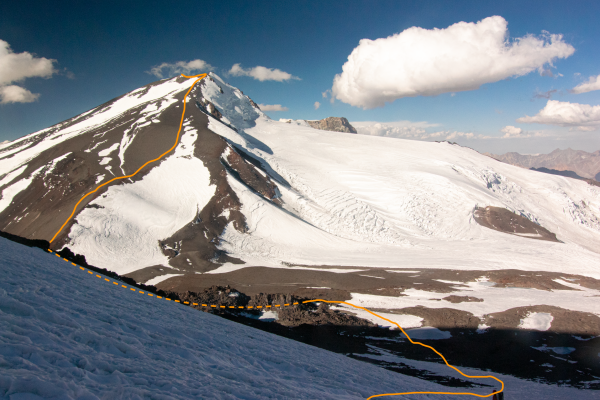
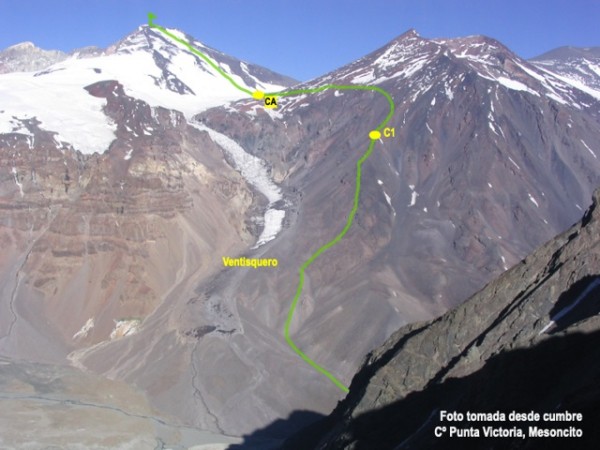
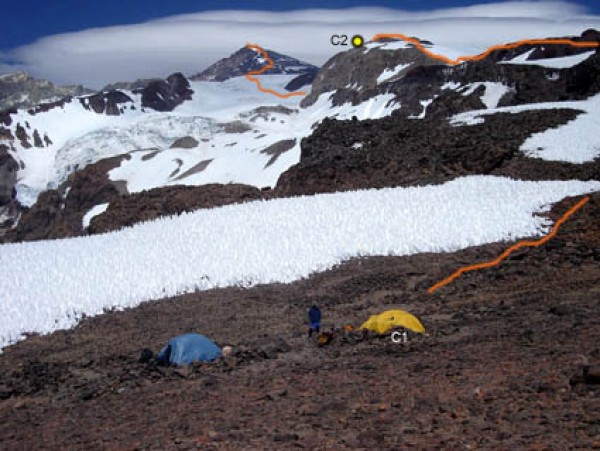
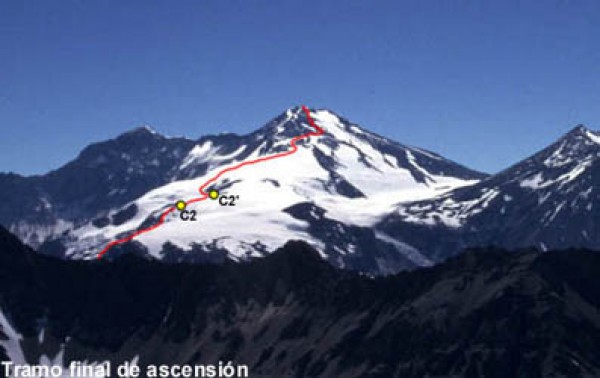
 Sign the summit book
Sign the summit book